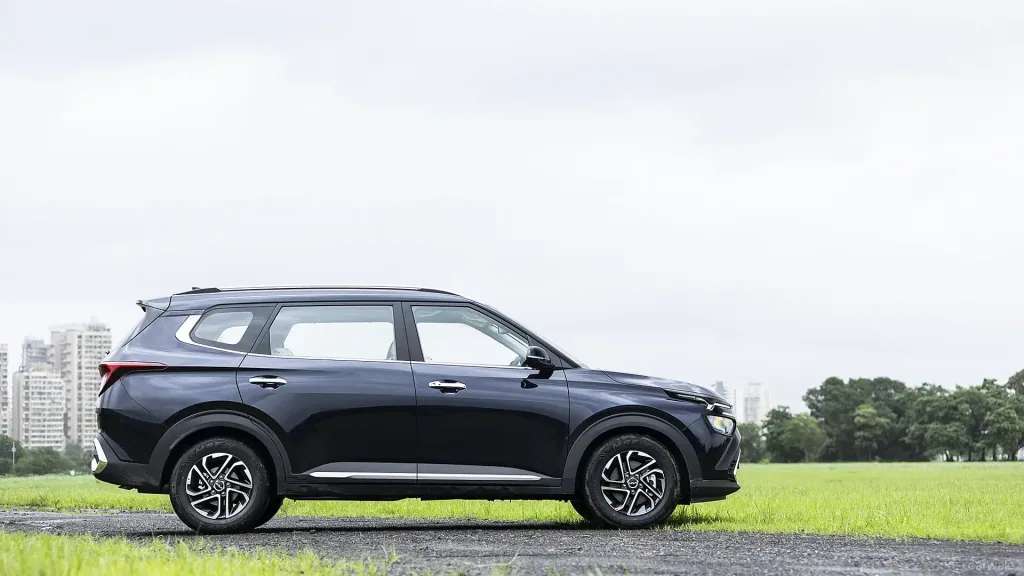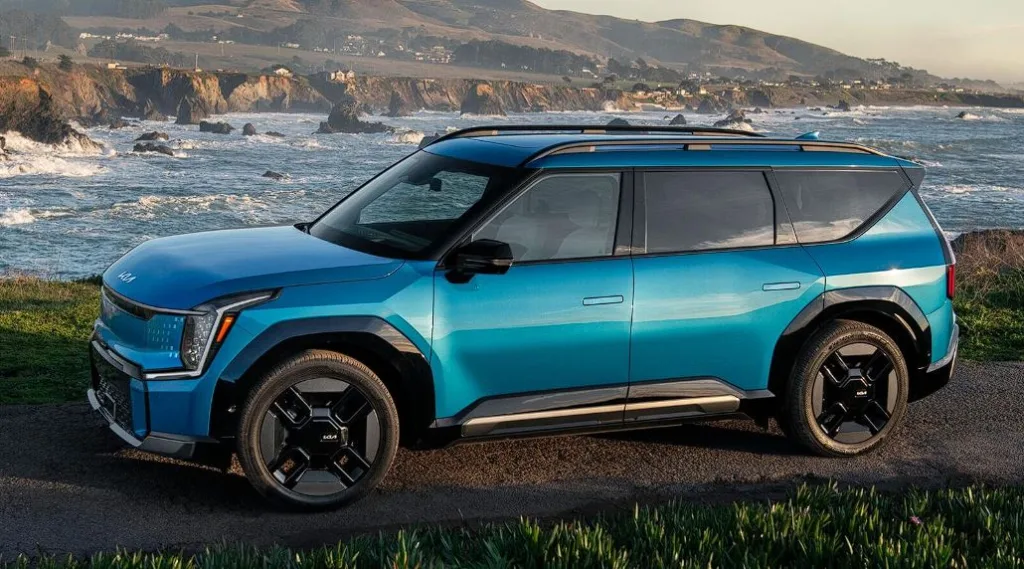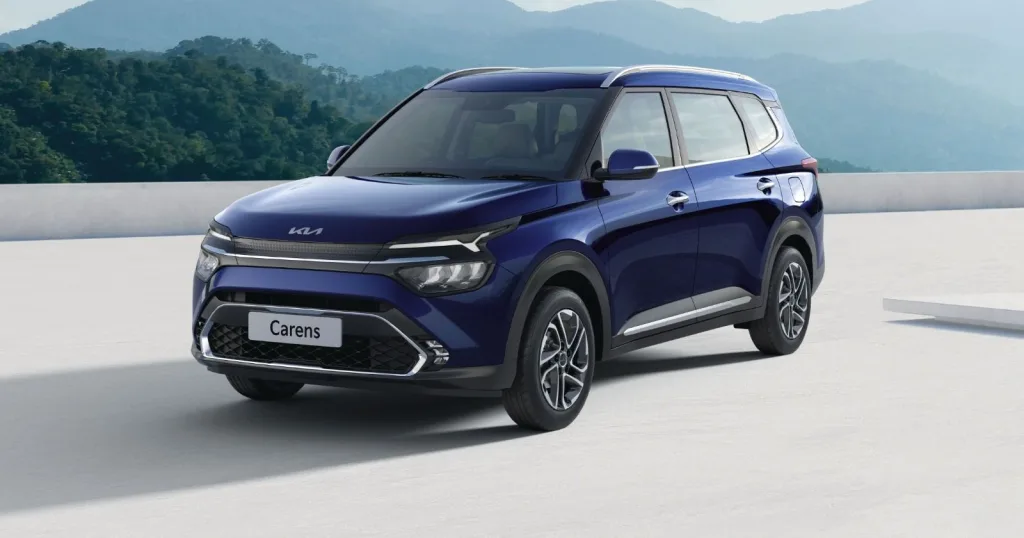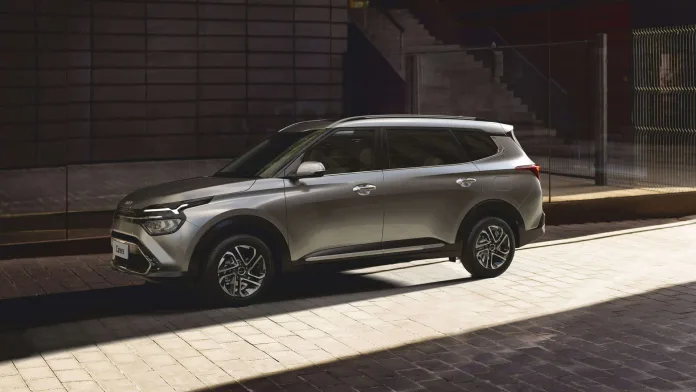The Kia Carens EV marks a significant milestone as India’s first electric Multi-Purpose Vehicle, revolutionizing the family car segment with advanced technology and zero-emission capabilities. This groundbreaking addition to the Kia EV lineup in India specifically targets modern families seeking sustainable transportation without compromising on space or functionality.
Additionally, the Kia Carens EV stands out with its comprehensive ADAS features, bringing semi-autonomous driving capabilities to the MPV segment. Importantly, this electric transformation of the popular Carens model combines practical family-oriented design with cutting-edge safety technology, positioning itself as a game-changer in the Indian automotive market.
Kia Unveils Revolutionary ADAS Features in Carens EV
Recent spy shots reveal that Kia is integrating advanced driver assistance systems (ADAS) in the upcoming Kia Carens EV, marking a significant technological leap for the MPV segment in India. The test mule, despite heavy camouflage, clearly shows an ADAS sensor on the lower section of the fascia, confirming Kia’s commitment to bringing cutting-edge safety technology to family vehicles.

Level 2 ADAS Brings Semi-Autonomous Driving to MPV Segment
The Carens EV will feature a Level 2 ADAS suite, representing a first-in-segment offering for the Indian electric MPV market. Level 2 automation allows the vehicle to handle both steering and speed control in certain situations, though drivers must remain alert and ready to take over at any time. This level of automation differs significantly from basic Level 0 and Level 1 systems, offering much more comprehensive assistance.
For drivers, these Level 2+ systems provide tangible comfort benefits, intelligently connecting features like lane centering control and adaptive cruise control. Together, these systems allow drivers to briefly take their hands off the wheel and feet off the pedals in specific driving scenarios, enhancing both safety and driving comfort.
The system is expected to include:
- Highway driving support with semi-autonomous features
- Adaptive cruise control that maintains safe distances
- Lane centering and lane keeping assistance
- Automated lane change capabilities
Front-Mounted Sensors Enable Advanced Safety Functions
The Kia Carens EV’s ADAS implementation relies on strategically placed sensors throughout the vehicle. Spy shots confirm a camera mounted on the windshield, which is essential for functions like lane departure warning and forward collision detection. Furthermore, front parking sensors have been spotted in the bumper, working alongside the ADAS system to provide comprehensive environmental awareness.
According to reliable sources, the Kia Carens EV will also incorporate side sensors, similar to those introduced in the recently launched Kia Syros. This multi-sensor approach creates a 360-degree awareness bubble around the vehicle, crucial for features like blind spot detection and automated parking assistance.
Moreover, the presence of ORVM-mounted side cameras suggests the inclusion of a 360-degree camera system, further enhancing the vehicle’s perception capabilities. This comprehensive sensor array works together to support the entire ADAS suite, enabling features that can potentially prevent accidents or mitigate their severity.
How ADAS Will Transform Family Travel Safety
ADAS technology has proven effective in reducing road accidents, with studies showing that vehicles equipped with both Automatic Emergency Braking and Blind Spot Warning systems were 23% less likely to crash than unequipped cars. Consequently, these systems are particularly valuable for family vehicles where safety is a paramount concern.
The Kia Carens EV’s ADAS features will build upon Kia’s already robust safety package, which currently includes anti-lock braking, electronic stability control, vehicle stability management, and hill-start assist control. The addition of advanced driver assistance technologies significantly enhances these foundational safety elements.
For family travelers, these systems provide an extra layer of protection during long journeys. Features like automatic emergency braking can detect obstacles or vehicles in the path and apply brakes automatically to avoid or reduce collision impact. Meanwhile, lane departure warning and lane keeping assist alert drivers if the vehicle drifts out of its lane and can gently steer back on track – particularly valuable during highway driving when fatigue may set in.
Studies indicate ADAS technology could potentially reduce front-to-rear crashes by up to 43% and injury rates by 45%. Therefore, by incorporating these advanced systems, the Carens EV is poised to set new safety standards for family transportation in India, addressing one of the most critical aspects of vehicle ownership for families.
The comprehensive nature of the Kia Carens EV’s ADAS package aligns with growing consumer demand for enhanced safety features, particularly as ADAS adoption continues to increase globally. Indeed, predictions suggest that fifty percent of all automobiles on the road by 2030 will be ADAS-enabled, placing the Kia Carens EV at the forefront of this important automotive safety trend in the Indian market.

Carens EV Borrows Powertrain from Hyundai Creta Electric
While the Kia Carens EV showcases innovative design and safety features, its powertrain technology comes from a familiar source. The upcoming electric MPV will share its electric powertrain architecture with the recently launched Hyundai Creta Electric, leveraging the synergy between the two Korean automakers.
Dual Battery Options Offer Flexible Range Choices
Families considering the Kia Carens EV will have flexibility in choosing a power option that best suits their needs and budget. Following the Creta Electric’s approach, Kia plans to offer two distinct battery pack options:
- A smaller 42 kWh battery pack delivering an ARAI-claimed range of approximately 390 km on a single charge
- A larger 51.4 kWh battery pack offering a more substantial ARAI-claimed range of 473 km
This dual-battery strategy allows Kia to cater to different customer segments – from urban commuters who primarily need a city runabout to families requiring longer range for weekend getaways. With claimed ranges between 390-473 km depending on the battery configuration, the Carens EV positions itself as a practical choice for various driving scenarios.
In terms of charging capabilities, the Kia Carens EV is expected to support both AC and DC fast charging options. While specific charging times haven’t been officially confirmed, the vehicle will likely mirror the Creta Electric’s charging profile – approximately 4 hours for a full charge using an 11kW AC charger (10% to 100%) and around 58 minutes for a 10% to 80% charge using a 50kW DC fast charger.
Single Motor Setup Delivers Impressive Performance Figures
Unlike some electric vehicles that employ dual-motor configurations, the Kia Carens EV will adopt a single-motor setup driving the front wheels. This approach balances performance with efficiency – a crucial consideration for a family-oriented vehicle.
The performance specifications align with the Creta Electric’s capabilities, with:
- The 42 kWh battery variant generating approximately 135 PS (133 bhp) from its electric motor
- The 51.4 kWh battery variant producing a more robust 169-171 bhp
- Maximum torque figures ranging between 200-255 Nm, with immediate delivery characteristic of electric powertrains
For the most part, these figures represent a significant performance upgrade compared to the current ICE Carens variants. The electric powertrain delivers instant torque, enabling quicker acceleration and smoother driving dynamics – particularly valuable in urban environments.
Nevertheless, the single-motor front-wheel-drive configuration emphasizes efficiency over outright performance, aligning with the vehicle’s practical family car positioning. This architecture eliminates the additional weight, complexity, and cost of a dual-motor setup while still providing adequate power for everyday driving scenarios.
As a result, the Kia Carens EV will become Kia’s most affordable electric vehicle in India, making electric family transportation more accessible. The shared powertrain with the Creta Electric allows Kia to leverage economies of scale, potentially reducing both development and production costs. In fact, this platform-sharing approach has been a successful strategy for the Hyundai Motor Group across multiple markets.
Given these points, the Kia Carens EV’s powertrain represents a balanced approach to family-oriented electric mobility, emphasizing range, practicality, and value rather than focusing solely on performance metrics.

Spy Shots Reveal EV5-Inspired Design Elements
Spy shots captured in South Korea and India have unveiled key design elements of the upcoming Kia Carens EV, showcasing clear inspiration from Kia’s global electric vehicle lineup, particularly the EV5. Despite heavy camouflage, recent test mules reveal distinctive styling cues that differentiate it from its internal combustion engine counterpart.
Triangular Headlamps with Connected LED DRL Strip
The most striking feature of the Carens electric MPV is its redesigned front fascia. Spy images clearly show triangular-shaped LED headlamp housings with projector units, a significant departure from the current model’s design. Notably, these headlamps connect to slim LED daytime running lights positioned at either edge of the hood.
Completing this modern lighting signature is a connected LED DRL strip that spans the width of the front end. This lighting architecture bears a strong resemblance to other Kia electric vehicles, establishing a cohesive design language across the brand’s growing EV portfolio. The front bumper has been completely redesigned as well, featuring a chunky silver-finished faux skid plate that adds a rugged touch to the electric MPV.
Aerodynamic Alloy Wheels Enhance Efficiency
Apart from the front-end redesign, the Kia Carens EV test mule sports distinctive alloy wheels designed specifically for improved aerodynamic efficiency. The spy shots reveal 19-inch aero-optimized wheels that differ significantly from those found on the internal combustion engine version of the Carens.
These aerodynamically designed wheels primarily serve a functional purpose rather than just aesthetic appeal. By reducing air turbulence around the wheel wells, they help minimize drag and maximize the vehicle’s electric range. Interestingly, the design of these wheels appears to take direct inspiration from larger Kia electric models like the EV9, further reinforcing the family resemblance across Kia’s electric lineup.
Kia Engineers Advanced Cabin Technology for Electric MPV
Beyond its electric powertrain and safety features, the Kia Carens EV incorporates advanced cabin technologies that elevate the in-car experience. The interior enhancements focus on convenience, connectivity, and comfort for all occupants.
12.3-inch Dual Display Setup Modernizes Dashboard
The Kia Carens EV interior features a sophisticated 12.3-inch dual digital display setup, replacing the current model’s 10.25-inch screens. This upgrade includes a 12.3-inch touchscreen infotainment system paired with a 12.3-inch fully digital instrument cluster. Together, these screens create a connected cockpit experience, providing drivers with clear access to vehicle information, navigation, and entertainment functions. The larger displays allow for improved visibility and enhanced user interface designs.
Wireless Charging and Connectivity Options
Located in front of the center console, the wireless smartphone charging system comes with an innovative cooling function. This prevents phones from overheating during the charging process. The charging status appears directly on the infotainment system, with color-coded indicators: orange for charging in progress, green for completed charging, and red for errors.
The cabin technology package is completed with Kia Connect features, offering seamless integration between the vehicle and smartphones or smartwatches. This enables remote functions such as:
- Engine start/stop from the smartphone app
- Remote climate control settings
- Vehicle status monitoring
- Seat ventilation control from a distance
These technological advancements position the Carens EV as a thoroughly modern electric family vehicle in the Indian market.
How Carens EV Stacks Up Against BYD eMAX 7
As India’s electric MPV market takes shape, the Kia Carens EV positions itself as a direct competitor to the recently launched BYD eMAX 7. Understanding how these two vehicles compare reveals important distinctions for potential buyers considering an electric family hauler.
Price Advantage Makes Electric Family Travel More Accessible
The most striking difference between these electric MPVs lies in their price positioning. The Kia Carens EV is expected to be priced between Rs 16-18 lakh, making it substantially more affordable than the BYD eMAX 7, which starts at Rs 26.90 lakh and goes up to Rs 29.90 lakh. This price gap of approximately Rs 10 lakh gives the Carens EV a significant advantage for families seeking to enter the electric vehicle market without stretching their budget.
A direct comparison of the base variants shows the Kia Carens EV’s expected starting price of Rs 16 lakh versus the eMAX 7 Premium 6-seater at Rs 26.90 lakh, representing almost 40% cost savings for the Kia offering.
Range Comparison Reveals Competitive Positioning
Regarding driving range, both vehicles offer impressive capabilities:
| Vehicle | Battery Options | Claimed Range |
|---|---|---|
| Kia Carens EV | 42kWh / 51.4kWh | 390km / 473km |
| BYD eMAX 7 | 55.4kWh / 71.8kWh | 420km / 530km |
Although the BYD eMAX 7 offers slightly better maximum range with its larger battery pack, the difference is relatively minor considering the substantial price premium.
Feature-to-Feature Analysis Shows Value Proposition
Altogether, both vehicles offer comparable feature sets including:
- 6-airbag safety systems standard across variants
- Advanced infotainment systems (12.3-inch in Kia Carens EVs 12.8-inch in eMAX 7)
- Panoramic sunroof options
- Ventilated front seats in higher variants
Correspondingly, both models feature ADAS technology, although the BYD includes it only in the top Superior trim. The Kia Carens EVV is expected to offer ADAS across more variants, henceforth providing better value in the mid-range models.
Regarding interior space, the BYD eMAX 7 measures 4710mm in length versus the Carens’ 4540mm, providing slightly more room, albeit at a considerable price premium.
FAQs
When will the Kia Carens EV launch in India?
The Kia Carens EV is expected to launch in India in mid-2025. According to recent reports, Kia plans to introduce both the Carens EV and the Carens facelift together ahead of the festive season in 2025.
What is the expected price range of the Kia Carens EV?
The Kia Carens EV is expected to be priced between ₹16-18 lakh (ex-showroom), making it significantly more affordable than other electric MPVs in the market like the BYD eMAX 7 which starts at ₹26.90 lakh.
What will be the driving range of the Kia Carens EV?
The Carens EV will offer two battery options: a 42 kWh battery providing approximately 390 km of range, and a larger 51.4 kWh battery offering up to 473 km of range on a single charge (ARAI-claimed figures).
What are the ADAS features in the Kia Carens EV?
The Kia Carens EV will feature Level 2 ADAS (Advanced Driver Assistance Systems) including adaptive cruise control, lane keeping assist, automated lane change capabilities, forward collision warning, and emergency braking. These systems enable semi-autonomous driving in certain conditions while requiring driver supervision.
How does the Kia Carens EV compare to the BYD eMAX 7?
While the BYD eMAX 7 offers slightly better maximum range (530 km vs 473 km), the Carens EV has a significant price advantage with an expected starting price of ₹16 lakh compared to the eMAX 7’s ₹26.90 lakh. Both vehicles offer similar features like ADAS, panoramic sunroofs, and advanced infotainment systems.
What will power the Kia Carens EV?
The Carens EV will share its electric powertrain with the Hyundai Creta Electric, featuring a single-motor front-wheel-drive setup. The 42 kWh battery variant will produce approximately 135 PS (133 bhp), while the 51.4 kWh variant will generate around 169-171 bhp, with torque ranging between 200-255 Nm.
What charging options will be available for the Kia Carens EV?
The Carens EV will support both AC and DC fast charging. While specific charging times haven’t been officially confirmed, it’s expected to mirror the Creta Electric’s capabilities: approximately 4 hours for a full charge using an 11kW AC charger and around 58 minutes for a 10% to 80% charge using a 50kW DC fast charger.
Conclusion
Kia Carens EV stands out as a significant milestone for electric mobility in India. Through thoughtful integration of Level 2 ADAS technology, this family-focused MPV delivers enhanced safety alongside practical electric range options. The combination of EV5-inspired design elements, advanced cabin features, and competitive pricing makes it an attractive option for modern families.
The shared powertrain architecture with Hyundai Creta Electric allows Kia to offer dual battery choices, meeting diverse range requirements while keeping costs reasonable. Additionally, the comprehensive safety suite, including semi-autonomous driving capabilities, sets new standards for family transportation in the Indian market.
The strategic pricing advantage over competitors like BYD eMAX 7, coupled with modern features such as the panoramic sunroof and 12.3-inch dual displays, positions the Kia Carens EV as a practical choice for families ready to switch to electric mobility. This balance of technology, safety, and value demonstrates Kia’s understanding of Indian market needs, making the Kia Carens EV a compelling option in the growing electric vehicle segment.


